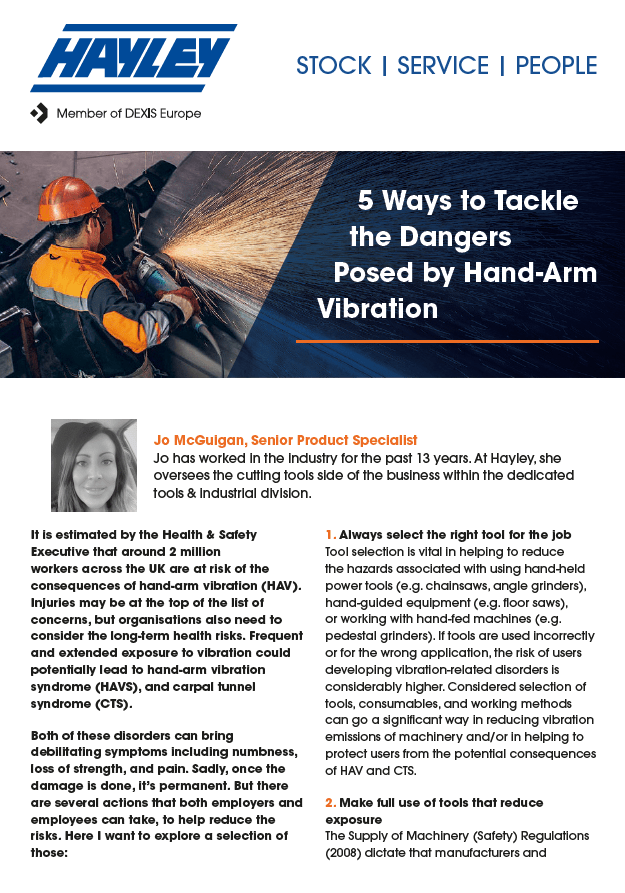by Jo McGuigan, Senior Product Specialist
Jo has worked in the industry for the past 13 years. At Hayley, she oversees the cutting tools side of the business within the dedicated tools & industrial division.
It is estimated by the Health & Safety Executive that around 2 million workers across the UK are at risk of the consequences of hand-arm vibration (HAV). Injuries may be at the top of the list of concerns, but organisations also need to consider the long-term health risks. Frequent and extended exposure to vibration could potentially lead to hand-arm vibration syndrome (HAVS), and carpal tunnel syndrome (CTS). Both of these disorders can bring debilitating symptoms including numbness, loss of strength, and pain. Sadly, once the damage is done, it’s permanent. But there are several actions that both employers and employees can take, to help reduce the risks. Here I want to explore a selection of those:
1. Always select the right tool for the job
Tool selection is vital in helping to reduce the hazards associated with using hand-held power tools (e.g. chainsaws, angle grinders), hand-guided equipment (e.g. floor saws), or working with hand-fed machines (e.g. pedestal grinders). If tools are used incorrectly or for the wrong application, the risk of users developing vibration-related disorders is considerably higher. Considered selection of tools, consumables, and working methods can go a significant way in reducing vibration emissions of machinery and/or in helping to protect users from the potential consequences of HAV and CTS.
2. Make full use of tools that reduce exposure
The Supply of Machinery (Safety) Regulations (2008) dictate that manufacturers and suppliers must provide details on the vibration emissions of their products. These details should be appropriate for calculating an estimation of vibration exposure. Organisations should make use of innovative products on the market, designed for enhanced performance, and with various safety features to minimise risk.
3M™ Cubitron™ II abrasives are a great example of this. They work up to 2x as fast as conventional alternatives, and using them means that less pressure from the operator is required to deliver a smooth cutting action. Reduced trigger time thanks to a faster cut rate means that jobs are completed faster and vibration exposure is reduced. The power of 3M™ Precision Shaped Ceramic Grain means a conventional bonded wheel can be replaced with a 3M™ Cubitron™ II fibre disc. Even on tough jobs like weld removal, this switch of an abrasive wheel to a less rigid construction of a fibre disc can also help reduce vibration exposure.
It’s clear that by using tools that are specifically designed to reduce the impact that vibration emissions can have upon users, associated risks can be reduced.
3. Maintain tools
The status and quality of all tools should be checked frequently as part of wider audits, to ensure they have no faults that could affect performance. Properly maintained and repaired tools will operate more efficiently than those with wear and tear. For instance, if cutting tools are kept sharp, the time required to complete tasks can be reduced. So too can the physical pressure users need to exert on the tools. More efficient tools offer a decreased risk of HAV to their users and also enable users to be more productive.
4. Set and maintain control measures
The Control of Vibration at Work Regulations came into force in 2005. The Regulations aim to protect those working with powered tools and equipment from the risks of vibration exposure. The law requires employers to ensure that risks of vibration are controlled and that all employees are adequately informed and trained in the safest use of equipment. It is also a requirement that employers provide suitable health surveillance for those working with the relevant hardware, to identify symptoms of HAVS and vibration-related CTS early.
The Vibration Regulations stipulate both an expose action value (2.5m/s² A(8)) and an exposure limit value (5m/s² A (8)). These are calculated using the vibration value at the grip-points and the time a worker is holding the tool at those points. By law, businesses must not allow exposures to exceed the exposure limit value (ELV).
To fully control risk and provide adequate health surveillance, it is essential to set, maintain, and communicate control measures based around the Regulations to your workforce – keeping them at the forefront of everybody’s minds.
5. Take steps to encourage blood circulation
Good circulation of blood helps to ward-off disorders caused by HAV, including vibration white finger (the most prevalent form of HAVS). Workers can take several steps to encourage their own good blood circulation. However, it’s important to note that these actions can only have a positive impact if the right steps around tool selection and usage have already been taken. By wearing the correct workwear to ensure they keep warm and dry while at work, users can limit their chances of developing problems. Practising a simple massage and/or exercise routine for the hands and fingers can also help to encourage proper blood flow to the affected areas. Smoking constricts blood flow, so cutting back on or quitting smoking can also help to prevent the onset of HAVS.
Hayley Group are partnered with 3M, a world-leading science-based technology company committed to improving the safety and productivity of individuals and businesses.



